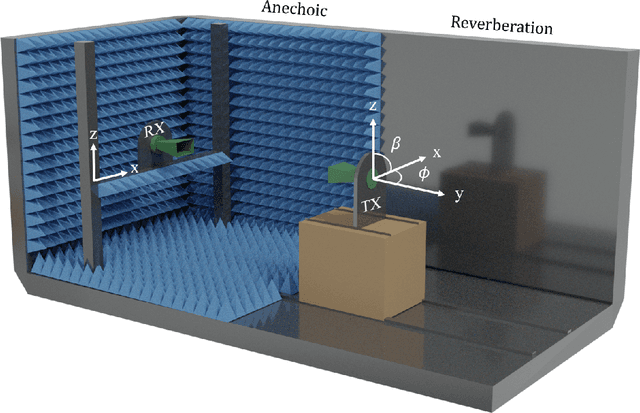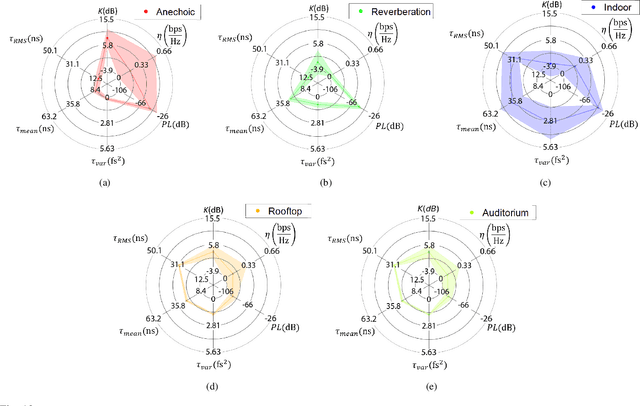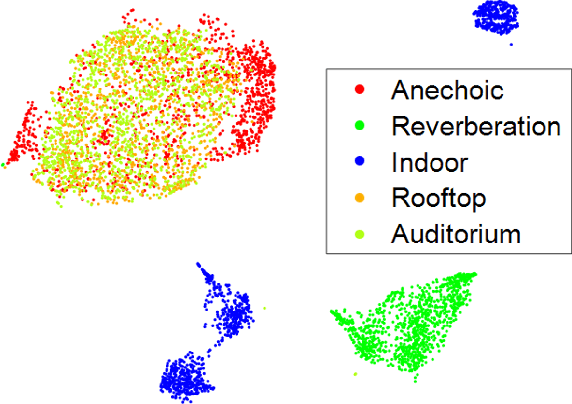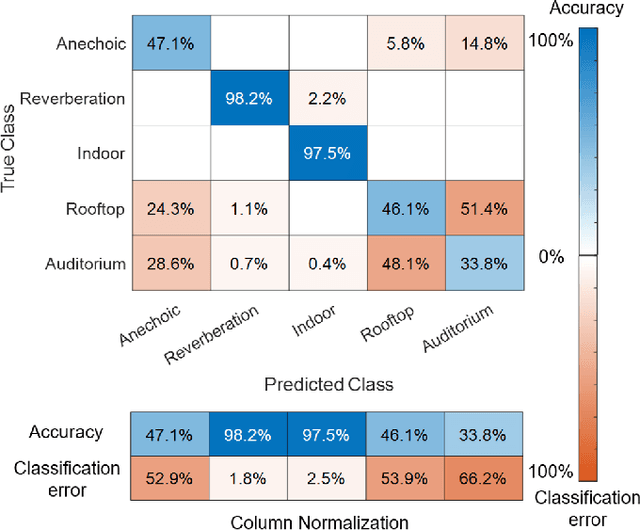Alejandro Ramírez-Arroyo
Experimental Assessment of Human Blockage at sub-THz and mmWave Frequency Bands
Nov 20, 2024



Abstract:The fifth generation (5G) of mobile communications relies on extremely high data transmissions using a large variety of frequency bands, such as FR1 (sub-6 GHz) and FR2 (mmWave). Future mobile communications envisage using electromagnetic spectrum beyond FR2, i.e. above 100 GHz, known as sub-THz band. These new frequencies open up challenging scenarios where communications shall rely on a major contribution such as the line-of-sight (LoS) component. To the best of the authors' knowledge, for the first time in literature this work studies the human blockage effects over an extremely wide frequency band from 75 GHz to 215 GHz given: (i) the distance between the blocker and the antennas and (ii) the body orientation. Furthermore, the obtained results are modeled with the classical path loss models and compared to 3GPP alternatives. The average losses increase from 42 dB to 56 dB when frequency rises from 75 GHz to 215 GHz. In terms of distance, a 18 dB increment in the received power is found when the Tx--Rx separation is increased from 1 m to 2.5 m. Finally, the blocker orientation induces variations of up to 4.6 dB.
Multi-Connectivity Solutions for Rural Areas: Integrating Terrestrial 5G and Satellite Networks to Support Innovative IoT Use Cases
Nov 11, 2024Abstract:5G cellular networks are now a reality and promise to improve key performance indicators (KPIs), such as Gbps data rates and latencies in the order of milliseconds. While some of these KPIs are achievable in urban scenarios, rural areas often face challenging connectivity conditions due to the lack of terrestrial network (TN) infrastructure. To solve this problem, non-terrestrial networks (NTNs) such as satellite-based solutions, have been introduced to provide coverage in remote regions. Therefore, a multi-connectivity approach can be integrated to simultaneously serve an end-user by merging satellite and cellular links in a joint approach. This study explores, using experimental data, the benefits of both TN-TN and TN-NTN multi-connectivity in rural environments. The results obtained demonstrate that a traditional single-connectivity approach may not be sufficient to provide service to rural environments due to the KPIs requirements given several use cases within these rural areas. The multi-connectivity strategy, which jointly integrates 5G and satellite networks, meets the network availability requirements for latency, downlink throughput, and uplink throughput KPIs at least 98%, 99%, and 95% of the time, respectively, for several use cases, such as precision agriculture, livestock monitoring, and forest management. These include applications like microclimate monitoring, remote operational support, early pest detection, and real-time tracking of livestock transport.
Observations on Large-Scale Attenuation Effects in a 26 GHz Urban Micro-Cell Environment
Apr 08, 2024Abstract:This letter presents a measurement campaign carried out in an FR2 urban outdoor environment in a live experimental network deployment. The radio propagation analysis from a physical perspective at 26 GHz is essential for the correct deployment and dimensioning of future communication networks. This study summarises and evaluates some of the typical effects encountered in a communications scenario such as penetration losses in a building, losses due to vegetation or the human body, or diffraction/scattering propagation around corners in street canyon-like environment given a FR2 live network.
FR2 5G Networks for Industrial Scenarios: An Experimental Characterization and Beam Management Procedures in Operational Conditions
Aug 17, 2023Abstract:Industrial environments constitute a challenge in terms of radio propagation due to the presence of machinery and the mobility of the different agents, especially at mmWave bands. This paper presents an experimental evaluation of a FR2 5G network deployed in an operational factory scenario at 26 GHz. The experimental characterization, performed with autonomous mobile robots that self-navigate the industrial lab, leads to the analysis of the received power along the factory and the evaluation of reference path gain models. The proposed assessment deeply analyzes the physical layer of the communication network under operational conditions. Thus, two different network configurations are assessed by measuring the power received in the entire factory, providing a comparison between deployments. Additionally, beam management procedures, such as beam recovery, beam sweeping or beam switching, are analyzed since they are crucial in environments where mobile agents are involved. They aim for a zero interruption approach based on reliable communications. The results analysis shows that beam recovery procedures can perform a beam switching to an alternative serving beam with power losses of less than 1.6 dB on average. Beam sweeping analysis demonstrates the prevalence of the direct component in Line-of-Sight conditions despite the strong scattering component and large-scale fading in the environment.
Empirical Validation of a Class of Ray-Based Fading Models
Jul 28, 2023Abstract:As new wireless standards are developed, the use of higher operation frequencies comes in hand with new use cases and propagation effects that differ from the well-established state of the art. Numerous stochastic fading models have recently emerged under the umbrella of generalized fading conditions, to provide a fine-grain characterization of propagation channels in the mmWave and sub-THz bands. For the first time in literature, this work carries out an experimental validation of a class of such ray-based models, in a wide range of propagation conditions (anechoic, reverberation and indoor) at mmWave bands. We show that the independently fluctuating two-ray (IFTR) model has good capabilities to recreate rather dissimilar environments with high accuracy. We also put forth that the key limitations of the IFTR model arise in the presence of reduced diffuse propagation, and also due to a limited phase variability for the dominant specular components.
Joint Ultra-wideband Characterization of Azimuth, Elevation and Time of Arrival with Toric Arrays
Jul 24, 2023



Abstract:In this paper, we present an analytical framework for the joint characterization of the 3D direction of arrival (DoA), i.e., azimuth and elevation components, and time of arrival (ToA) in multipath environments. The analytical framework is based on the use of nearly frequency-invariant beamformers (FIB) formed by toric arrays. The frequency response of the toric array is expanded as a series of phase modes, which leads to azimuth-time and elevation-time diagrams from which the 3D DoA and the ToA of the incoming waves can be extracted over a wide bandwidth. Firstly, we discuss some practical considerations, advantages and limitations of using the analytical method. Subsequently, we perform a parametric study to analyze the influence of the method parameters on the quality of the estimation. The method is tested in single-path and multipath mm-wave environments over a large bandwidth. The results show that the proposed method improves the quality of the estimation, i.e., decreases the level of the artifacts, compared to other state-of-art FIB approaches based on the use of single/concentric circular and elliptical arrays.
Joint Direction-of-Arrival and Time-of-Arrival Estimation with Ultra-wideband Elliptical Arrays
Jul 26, 2022



Abstract:This paper presents a general technique for the joint Direction-of-Arrival (DoA) and Time-of-Arrival (ToA) estimation in multipath environments. The proposed ultra-wideband technique is based on phase-mode expansions and the use of nearly frequency-invariant elliptical arrays. New possibilities open with the present approach, as not only elliptical, but also circular and linear arrays can be considered with the same implementation. Systematic selection/rejection of signals-of-interest/signals-not-of-interest in smart wireless environments is possible, unlike with previous approaches based on circular arrays. Concentric elliptical arrays of many sizes and eccentricities can be jointly considered, with the subsequent improvement that entails in DoA and ToA detection. This leads to the realization of pseudo-random array patterns; namely, quasi-arbitrary geometries created from the superposition of multiple elliptical arrays. Some simulation and experimental tests (measurements in an anechoic chamber) are carried out for several frequency bands to check the correct performance of the method. The method is proven to give accurate estimations in all tested scenarios, and to be robust against noise, channel nonidealities, position uncertainty in sensor placement and interferences.
Artificial Intelligence and Dimensionality Reduction: Tools for approaching future communications
Dec 20, 2021



Abstract:This article presents a novel application of the t-distributed Stochastic Neighbor Embedding (t-SNE) clustering algorithm to the telecommunication field. t-SNE is a dimensionality reduction (DR) algorithm that allows the visualization of large dataset into a 2D plot. We present the applicability of this algorithm in a communication channel dataset formed by several scenarios (anechoic, reverberation, indoor and outdoor), and by using six channel features. Applying this artificial intelligence (AI) technique, we are able to separate different environments into several clusters allowing a clear visualization of the scenarios. Throughout the article, it is proved that t-SNE has the ability to cluster into several subclasses, obtaining internal classifications within the scenarios themselves. t-SNE comparison with different dimensionality reduction techniques (PCA, Isomap) is also provided throughout the paper. Furthermore, post-processing techniques are used to modify communication scenarios, recreating a real communication scenario from measurements acquired in an anechoic chamber. The dimensionality reduction and classification by using t-SNE and Variational AutoEncoders (VAE) show good performance distinguishing between the recreation and the real communication scenario. The combination of these two techniques opens up the possibility for new scenario recreations for future mobile communications. This work shows the potential of AI as a powerful tool for clustering, classification and generation of new 5G propagation scenarios.
 Add to Chrome
Add to Chrome Add to Firefox
Add to Firefox Add to Edge
Add to Edge